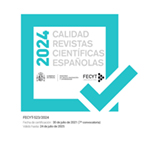Transformation and Evolution in the Anthroponym Glyphic Representation of Pre-Hispanic Mexican Rulers
Abstract
Continuities and strategies used to represent Nahuatl anthroponyms, show different adaptive responses in the development of writing, the degree of diversification in production areas or transformations inherent to the historical context of the indigenous painters. These strategies can be observed from a first epigraphic to a later paleographic point-of-view, expressed by Mexica rulers glyphic name in pre-Hispanic times to late colonial period. After contact, these names appear collected in codices and documents, combined with cultural background and capability of the scribes. We analyze 463 glyphs of these eleven rulers, looking for how they evolved over time until the 18th century.
Downloads
Article download
License
In order to support the global exchange of knowledge, the journal Revista Española de Antropología Americana is allowing unrestricted access to its content as from its publication in this electronic edition, and as such it is an open-access journal. The originals published in this journal are the property of the Complutense University of Madrid and any reproduction thereof in full or in part must cite the source. All content is distributed under a Creative Commons Attribution 4.0 use and distribution licence (CC BY 4.0). This circumstance must be expressly stated in these terms where necessary. You can view the summary and the complete legal text of the licence.









